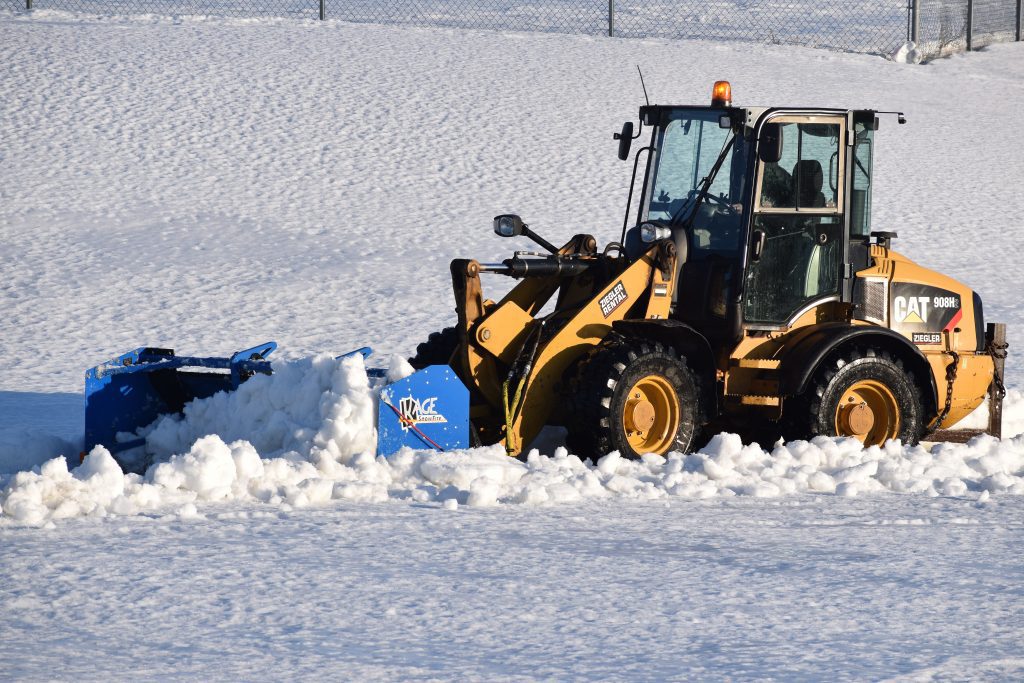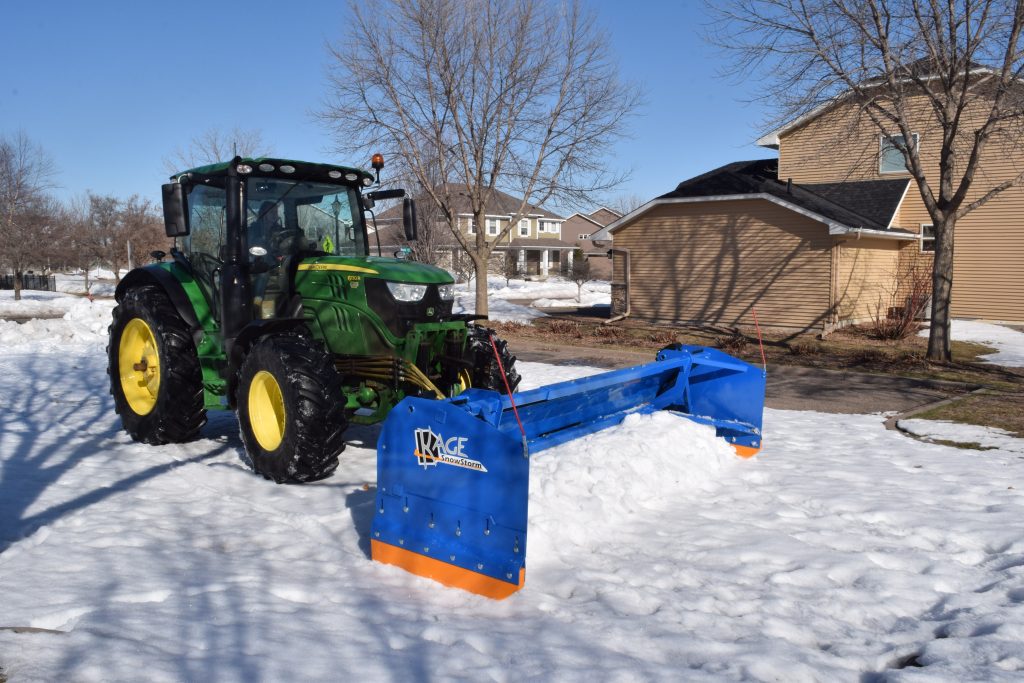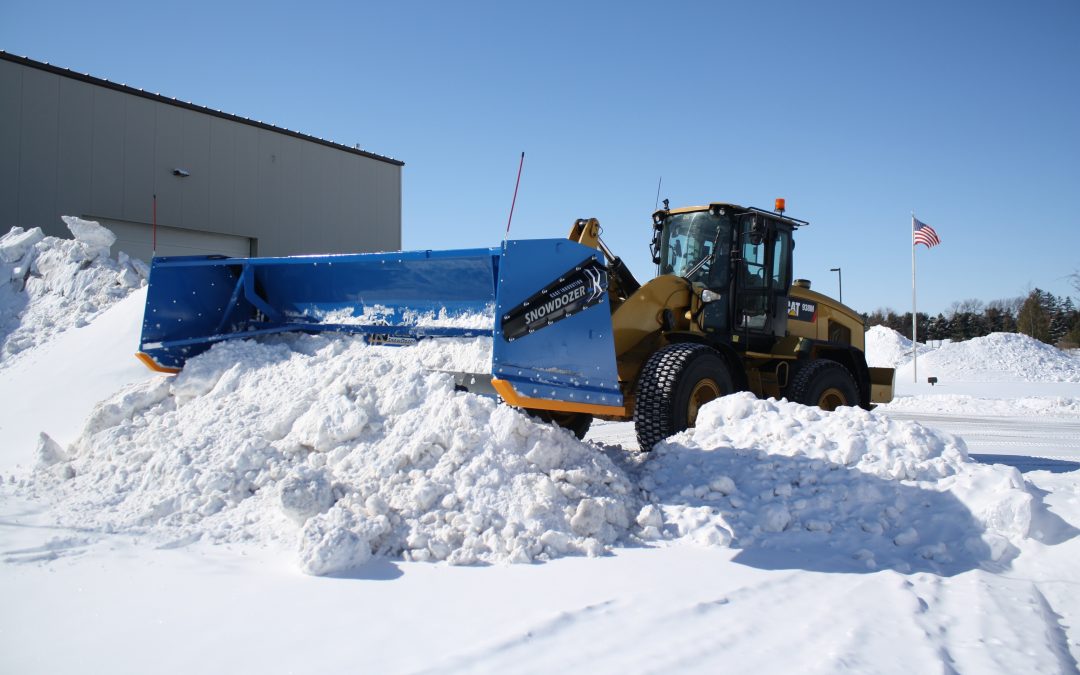Snow plow weight can have significant implications for the skid steer, wheel loader, or tractor it is mounted on. Here’s how:
- Weight Distribution: When a snow plow is mounted on a skid steer, wheel loader, or tractor, it adds extra weight to the front of the vehicle. This can affect the vehicle’s balance and stability, especially if the weight distribution becomes uneven. Operators need to be mindful of this imbalance, particularly when navigating uneven terrain or steep slopes, as it can increase the risk of tipping over.
- Traction: The added weight of the snow plow can improve traction, especially in snowy or icy conditions. This increased traction allows the vehicle to maintain better control and maneuverability while pushing or lifting snow. However, excessive weight can also put strain on the vehicle’s tires and suspension system, potentially causing premature wear and tear.
- Power Requirements: The weight of the snow plow can affect the vehicle’s power requirements. Heavier plows may require more horsepower to operate effectively, especially when dealing with deep or heavy snow. This can put additional strain on the vehicle’s engine and drivetrain, leading to increased fuel consumption and potential overheating if the vehicle is not adequately equipped to handle the load.
- Impact on Handling and Performance: The weight of the snow plow can impact the handling and performance of the vehicle. Heavier plows may affect steering responsiveness and agility, making it more challenging to maneuver in tight spaces or around obstacles. Additionally, the added weight can affect acceleration and braking distances, requiring operators to adjust their driving techniques accordingly.
- Structural Integrity: Mounting a heavy snow plow on a skid steer, wheel loader, or tractor can put stress on the vehicle’s frame and chassis. Over time, this constant strain can lead to structural fatigue and potentially cause damage or failure if the vehicle is not designed to handle the added weight. Regular inspections and maintenance are essential to ensure the structural integrity of the vehicle is maintained.
The weight of a snow plow can also significantly impact its ability to scrape effectively. Here’s how:
- Downward Force: The weight of the snow plow provides downward force, which is essential for effectively scraping snow and ice from the surface. A heavier plow exerts more pressure on the ground, allowing it to make better contact with the surface and remove snow more efficiently. This downward force helps to break the bond between the snow and the pavement, facilitating more effective removal. However, weight alone does not ensure a clean scrape it is also important to have the right cutting edge material and design as well as a proper attack angle.
- Penetration Depth: The weight of the snow plow influences how deeply it can penetrate into packed snow and ice. Heavier plows can penetrate deeper into the snowpack, reaching down to the pavement and ensuring thorough clearing. This is particularly important when dealing with dense or compacted snow that may be more challenging to remove.
- Stability and Control: While weight is crucial for effective scraping, it’s essential to strike a balance to maintain stability and control. Excessive weight can make the plow difficult to maneuver, especially in tight spaces or on uneven terrain. It’s important to find the optimal weight for the specific vehicle and conditions to achieve the best balance between scraping performance and maneuverability.
- Durability: The weight of the snow plow can also impact its durability and longevity. Heavy-duty plows are typically designed to withstand the rigors of heavy snowfall and frequent use. However, excessive weight can put strain on the plow’s components, leading to premature wear and potential damage. It’s essential to choose a plow that is appropriately sized and built to handle the intended workload.
- Fuel Efficiency: While weight is necessary for effective scraping, it can also impact fuel efficiency. Heavier plows may require more fuel to operate, especially when lifting and moving large amounts of snow. It’s important to consider the fuel consumption of the vehicle when selecting a snow plow to ensure optimal efficiency and cost-effectiveness. With the proper curvature of the moldboard, you can help increase fuel efficiency of heavy plows as the snow will roll in front of windrow off the plow, rather than pack together for a tough push.
While the weight of a snow plow can provide benefits such as improved traction and snow-clearing capabilities, it also presents challenges in terms of vehicle stability & maneuverability, power requirements, handling, fuel efficiency and structural integrity. Operators should carefully consider these factors when selecting and using a snow plow to ensure safe and efficient operation. Additionally, choosing a properly sized and balanced plow for the vehicle can help minimize the negative impacts of added weight.
How much do snow plows weigh?
Skid Steer Snow Plow Weight

Lighter-duty skid steer snow plows, typically designed for smaller skid steer loaders and lighter snow removal tasks, may weigh around 300 to 600 pounds. These lighter plows are more maneuverable and suitable for clearing smaller areas, such as sidewalks and small driveways.
On the other hand, heavier-duty skid steer snow plows, intended for larger skid steer loaders and more demanding snow removal applications, can weigh upwards of 1,000 pounds or more. These heavy-duty plows are designed to withstand the rigors of commercial snow removal operations and are capable of clearing areas such as country roads, parking lots, housing developments or commercial properties.
The Kage SnowFire and SnowFire BLAST skid steer snow plows fall on the heavy-duty end of the spectrum. A 6-foot SnowFire blade weighs just over 900 pounds and is recommended for machines starting at 5,000 pounds, while a 12-foot SnowFire Blade weighs in just over 1,500 pounds and is designed for 8,500-plus-pound machines. Adding the containment boxes to these blades will increase the weight anywhere from 366 to 477 pounds, depending on the plow length.
SnowFire BLAST skid steer snow pushers have fixed sides and range from just under 1,400 pounds for a 6-footer to slightly over 1,800 pounds for a 12-footer.
It’s essential to consider the weight of the snow plow in relation to the skid steer loader’s lifting capacity and overall stability. Exceeding the loader’s weight capacity can compromise safety and performance, leading to potential accidents or equipment damage. Therefore, it’s crucial to select a snow plow that is appropriately sized and matched to the skid steer loader’s specifications to ensure safe and efficient operation.
Wheel Loader Snow Plow Weight

Lighter-duty wheel loader snow plows, designed for smaller wheel loaders and lighter snow removal tasks, may weigh around 1,000 to 5,000 pounds. KAGE’s SnowFire, SnowFire BLAST and SnowStorm Plows all fall into this category as the SnowStorm systems can range around 2,200 to 3,300 pounds each for 10′ to 14′ plows. A 10 foot SnowStorm system should be used on a machine weighing at least 14,500 pounds while the 14-footer is designed for machines weighing more than 19,000 pounds.
Heavy-duty wheel loader snow plows, intended for larger wheel loaders and more demanding snow removal applications, can weigh upwards of 5,000 pounds or more. These heavy-duty plows are built for larger commercial snow removal operations including as roads, highways, airport runways, large parking lots or industrial sites.
The KAGE SnowDozer wheel loader plow fits into the heavy duty classification, weighing in just shy of 5,000 pounds for a 12-foot blade with no box and weighing as much as 8,100 pounds for a 20-footer with the containment box. These snow blade and pusher systems are designed for machines weighing 25,000 to 50,000 pounds.
Again, consider the weight of the snow plow in relation to the wheel loader’s lifting capacity and overall stability to avoid compromising safety and performance.
Tractor Snow Plow Weight

Lighter-duty tractor snow plows, designed for smaller tractors and lighter snow removal tasks, may weigh around 300 to 1,000 pounds. These smaller plows are often used for clearing driveways, sidewalks, or smaller areas around residential properties.
Mid-range tractor snow plows, suitable for medium-sized tractors and more extensive snow removal applications, may weigh between 1,000 and 2,500 pounds. These plows are commonly used for clearing larger driveways, parking lots, gravel roads, or farmsteads. Falling into this range from the KAGE lineup are the SnowFire & SnowFire Blast.
Heavy-duty tractor snow plows, designed for large tractors and commercial snow removal operations, can weigh over 2,500 pounds, and some models may even exceed 8,000 pounds. These robust plows are capable of handling significant snow accumulation on large areas such as commercial properties, industrial sites. KAGE SnowStorm and SnowDozers are deemed heavy duty plows on tractors.
As with any snow plow equipment selecting a snow plow that is appropriately sized for the tractor’s capabilities is essential for snow removal operations.
How Do KAGE Plow Weights Compare Other Brands?
30″ Tall Plows
- Metal Pless PlowMaxx
- 6′ Length (1,640 lbs)
- 8′ Length (1,930 lbs)
- SnowWolf Quattro
- 8′ Length (1,269 lbs)
- 9′ Length (1,301 lbs)
- 10′ Length (1,345 lbs)
- SnowWolf Quattro XT
- 9′ length (1,484 lbs)
- 10′ length (1,540 lbs)
- 11′ length (1,575 lbs)
- HLA 2500
- 6′ Length (655 lbs)
- 8′ Length (725 lbs)
- HLA 3530W
- 6′ Length (1,390 lbs)
- 8′ Length (1,545 lbs)
- 9′ Length (1,616 lbs)
- 10′ Length (1,690 lbs)
32″ Tall Plows
- KAGE SnowFire
- 6′ Length (906-1,272 lbs)
- 8′ Length (1,031-1,473 lbs)
- 9′ Length (1,087-1,529 lbs)
- 10′ Length (1,147-1,589 lbs)
- 12′ Length (1,541-1,983 lbs)
- KAGE SnowFire Blast
- 6′ Length (1,379 lbs)
- 8′ Length (1,497 lbs)
- 9′ Length (1,554 lbs)
- 10′ Length (1,611 lbs)
- 12′ Length (1,812 lbs)
- Arctic Sectional Sno-Pusher
- 8′ Length (1,150 lbs)
- 10.5 Length (1,792 lbs)
- 13′ Length (2,050 lbs)
36″ Tall Plows
- KAGE SnowStorm
- 10′ Length (2,282-3088 lbs)
- 12′ Length (2,375-3,181 lbs)
- 14′ Length (2,468-3,274 lbs)
- Metal Pless PlowMaxx
- 10′ Length (2,427 lbs)
- 12′ Length (2,620 lbs)
- Metal Pless AgriMaxx
- 10′ Length (2,188 lbs)
- 12′ Length (2,380 lbs)
- Fisher Storm Boxx
- 10′ Length (2,337 lbs)
- Hiniker 3800
- 10′ Length – (917 lbs)
48″ Tall Plows
- KAGE SnowDozer
- 12′ Length (4,917-6,974 lbs)
- 14′ Length (5,114-7,170 lbs)
- 16′ Length (5,527-7,357 lbs)
- 18′ Length (5,722-7,846 lbs)
- 20′ Length (5,912-8,037 lbs)
- Metal Pless MaxxPro
- 18′ Length (4,700-4,800 lbs)
- 20′ Length (4,900-5,200 lbs)


Recent Comments